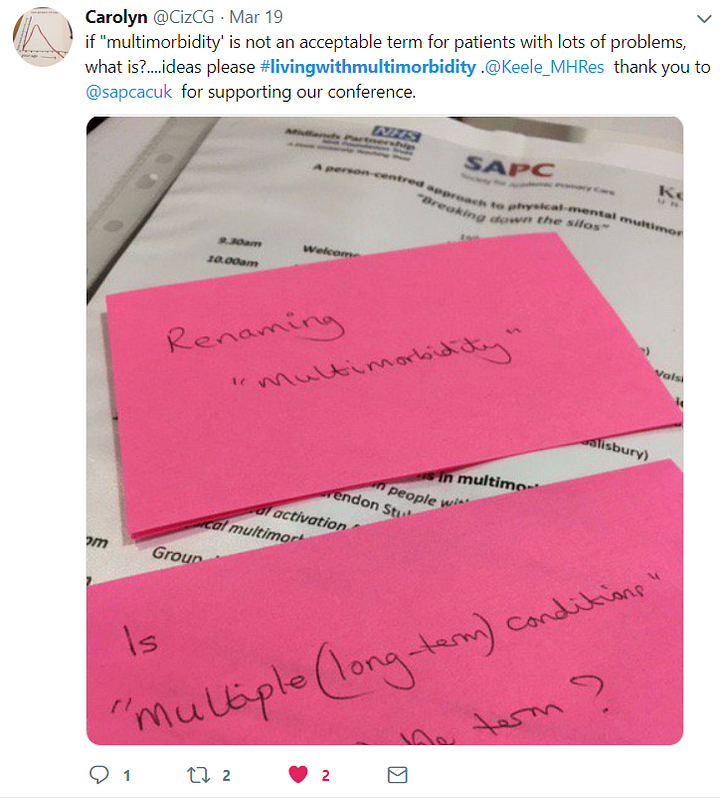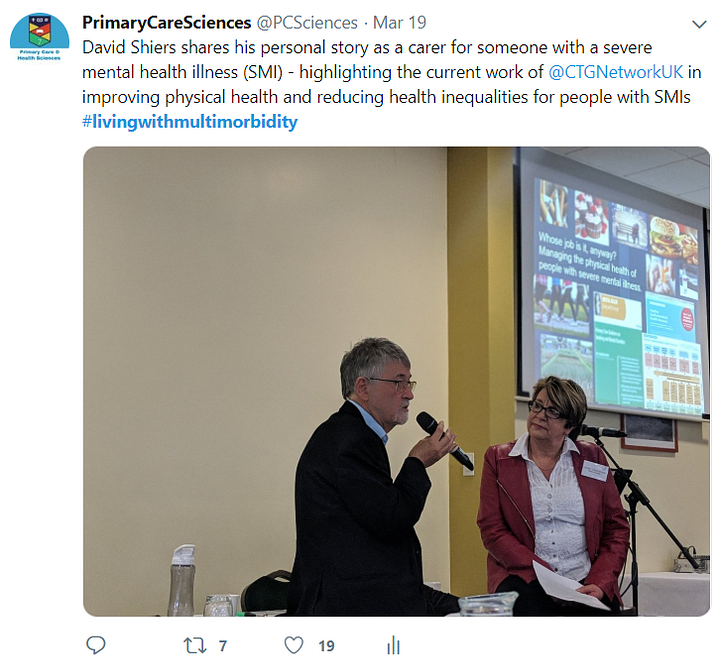Physical-mental multimorbidity: Breaking down the silos
2 May 2019
Written by Robyn Till | Research Institute for Primary Care & Health Sciences | Keele University | @PCSciences
first published as a Primary Care & Health Sciences blog
I was lucky enough to attend a workshop on the 19th March 2019 which was hosted by the Research Institute for Primary Care and Health Sciences in collaboration with the Midlands Partnership NHS Foundation Trust and the Society for Academic Primary Care (SAPC). The workshop, opened by Professor Pauline Walsh, Pro-vice Chancellor and Executive Dean, Faculty of Medicine and Health Sciences, Keele University, bought together stakeholders from a range of disciplines (including researchers, the public, carers, clinicians, commissioners) in order to deliver an interactive workshop focussed on physical-mental multimorbidity which I’ll try to summarise in this blog.
What is multimorbidity?
More prevalent than we realise, the number of people living with multimorbidity is on the rise, with 1 in 4 people experiencing multimorbidity. What do we mean when we say ‘multimorbidity?’
NICE define multimorbidity as ‘the presence of 2 or more long-term health conditions, which can include:
- defined physical and mental health conditions such as diabetes or schizophrenia
- ongoing conditions such as learning disability
- symptom complexes such as frailty or chronic pain
- sensory impairment such as sight or hearing loss
- alcohol and substance misuse.’
Any wiser? No? Well, for research purposes (sample size = 1), I asked my partner (a software engineer with no healthcare background) what he thought multimorbidity meant, to which he responded: “it sounds like a heavy metal band!” Had I not worked within the Institute for a number of years, I suspect I’d have a similar response.
The conference organisers, Dr Tom Kingstone, Dr Jonathan Quicke and Professor Carolyn Chew-Graham reiterated this point during their introductions, highlighting the issues with the current terminology. They asked delegates to consider and feedback how it could be renamed in a patient-friendly manner.

What are we currently doing?
Professor Carolyn Chew-Graham, a practising GP and researcher here at Keele, gave some insightful examples of what patient care can look like for patients with multiple conditions attending their general practice. She referred to the current NICE multimorbidity guidelines which make clinical recommendations for clinicians regarding best care. The guideline recognises that the management of each single condition can add to a patient’s treatment burden and there is a need to provide ‘personalised care’ for people with multiple conditions, taking account of their priorities and wishes.
Carolyn advised that there is still a long way to go in order to improve the way that we deliver patient-centred care for people with multiple conditions, emphasising the challenge in doing this in a 10-minute consultation. She highlighted the need for further research which will help to facilitate this, given that previous trials of the management of single diseases which contribute to evidence-based guidelines usually exclude patients with multimorbidities.
What should we be doing?

Next, we heard from guest speakers who summarised their research findings and experiences of physical-mental multimorbidity, each providing insights into various interventions;
Whole-person care
Professor Chris Salisbury from the University of Bristol summarised the 3-D study, the largest multimorbidity trial in primary care which looked at making health reviews more patient-centred — including involving patients in the planning and delivery of their care. The study showed that although patient satisfaction and measures of person-centred care improved, health-related quality of life (a measure which includes mobility, self-care, pain and discomfort, and anxiety and depression) did not improve. These results certainly provide food for thought, as they both challenge the current thinking on which UK and international guidelines are based and also whether health-related quality of life is the best outcome measure for such trials including people with multiple long term conditions.
Exercise
Dr Brendon Stubbs, Head of Physiotherapy at South London and Maudsley NHS Foundation Trust and Clinical Lecturer at King’s College London, outlined his work on physical activity and sedentary behaviour in people with physical and mental long-term conditions. His research provides evidence that integrated lifestyle interventions as a core part of people’s mental health treatments could have significant impacts on overall wellbeing and important clinical outcomes.

Behaviour Activation
University of York’s and Tees Esk and Wear Valleys NHS Foundation Trust, Professor David Ekers, shared his insights from both his own and other’s research on behavioural activation (BA) as a treatment option for patients with long-term conditions and depression. Various findings support the use of behavioural activation as an effective treatment, and he asked whether we should now be looking at using behavioural activation as a more global treatment for people with multimorbidities, rather than just focussing on depression. David mentioned the MODS study @MODS_Research, which is starting to develop an intervention based on BA for people with multimorbidity.

Severe mental illness
Professor Saeed Farooq (Keele University) and Dr David Shiers (former local GP and researcher at Greater Manchester Mental Health NHS Foundation Trust and University of Manchester) both highlighted the ever-increasing gap in mortality rates for patients with severe mental illness due to physical conditions. Dr Shiers shared his personal story as a carer for his daughter with schizophrenia, and Dr Saeed Farooq shared his research findings. Both highlighted the importance of better educating healthcare professionals, and improving access to facilities for patients with severe mental illness to support them to increase their physical activity and ensure appropriate diet. David and Carolyn highlighted the work of the ‘Closing the Gap’ network, members of which are working hard to close this mortality gap through research collaboration.

Next steps

To end the day, groups were asked to pitch a research idea to a panel of lay members from the Keele Research User Group. In just 90 minutes, delegates were able to produce 9 innovative research ideas, which had focussed on areas including health literacy, training for healthcare professionals, exercise interventions the wellbeing of healthcare professionals. These ideas will help the team and delegates shape their future funding applications.
The event was a great success which provided a great opportunity for stakeholders to network, share knowledge, and enter key discussions which will help us to break down the barriers surround physical-mental multimorbidity.
Special congratulations go to Daniel Heron (representing the INCLUDE team) who won the prize for best poster presentation, entitled ‘Acceptability of a nurse-led integrated primary care review for people with inflammatory rheumatological conditions: a qualitative evaluation.’
